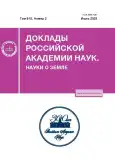NEW GEOCHRONOLOGICAL AND ISOTOPE DATA ON MESOZOIC GRANITOIDS OF EASTERN TRANSBAIKALIA
- Авторлар: Naryzhnova A.V.1, Khromykh S.V.1, Kruk N.N.1, Kotler P.D.1
-
Мекемелер:
- Institute of Geology and Mineralogy, Siberian Branch of the Russian Academy of Sciences
- Шығарылым: Том 510, № 2 (2023)
- Беттер: 181-188
- Бөлім: PETROLOGY
- ##submission.dateSubmitted##: 14.10.2023
- ##submission.datePublished##: 01.06.2023
- URL: https://journals.rcsi.science/2686-7397/article/view/135772
- DOI: https://doi.org/10.31857/S2686739723600170
- EDN: https://elibrary.ru/UKEPHO
- ID: 135772
Дәйексөз келтіру
Толық мәтін
Аннотация
Eastern Transbaikalia is a unique rare-metal province of Russia. Most of the studied deposits are associated with granitoid intrusions. Despite the high degree of knowledge of regional magmatism, a number of questions remain related to both the belonging of specific massifs to magmatic complexes and the correlation of certain complexes within various structural-formation zones. This paper compares the material composition and age of several petrotypical and parapetrotypical massifs classified as Late Mesozoic complexes distributed within the Aginskaya, Prishilkinskaya, and Argunskaya structural-formational zones of Eastern Transbaikalia. Based on the results of U-Pb dating, two stages of granitoid magmatism have been established: 1) the end of the Middle – the beginning of the Late Jurassic (163–156 million years ago) and 2) the beginning of the Early Cretaceous (142 million years ago). It is shown that the closely aged rocks of the Borshchovochny, Amudzhikano-Sretensky and Shakhtama complexes have similar material characteristics, while the rocks of the Kukulbey complex (from three massifs) vary in composition. Elevated δ18O values (from +10.8‰ to +11.9 ‰) for the rocks of the Jurassic complexes indicate their formation mainly due to the melting of crustal material, and lower δ18O values (from +9.8 ‰ up to +10.3‰) for the Early Cretaceous granitoids suggest the contribution of a mantle source to their genesis.
Негізгі сөздер
Авторлар туралы
A. Naryzhnova
Institute of Geology and Mineralogy, Siberian Branch of the Russian Academy of Sciences
Хат алмасуға жауапты Автор.
Email: naryzhnovav@igm.nsc.ru
Russian, Novosibirsk
S. Khromykh
Institute of Geology and Mineralogy, Siberian Branch of the Russian Academy of Sciences
Email: naryzhnovav@igm.nsc.ru
Russian, Novosibirsk
N. Kruk
Institute of Geology and Mineralogy, Siberian Branch of the Russian Academy of Sciences
Email: naryzhnovav@igm.nsc.ru
Russian, Novosibirsk
P. Kotler
Institute of Geology and Mineralogy, Siberian Branch of the Russian Academy of Sciences
Email: naryzhnovav@igm.nsc.ru
Russian, Novosibirsk
Әдебиет тізімі
- Андреева О.В., Петров В.А., Полуэктов В.В. Мезозойские кислые магматиты Юго-Восточного Забайкалья: петрогеохимия, связь с метасоматизмом и рудообразованием // Геология рудных месторождений. 2020. Т. 62 (1). С. 76–104.
- Владимиров А.Г., Ляхов Н.З., Загорский В.Е. и др. Литиевые месторождения сподуменовых пегматитов Сибири // Химия в интересах устойчивого развития. 2012. Т. 20 (1). С. 3–20.
- Государственная геологическая карта Российской Федерации. Масштаб 1:1 000 000 (третье поколение). Лист М‑50 – Борзя. Объяснительная записка. // СПб.: Картографическая фабрика ВСЕГЕИ. 2010. 553 с.
- Коваленко В.И., Сальникова Е.Б., Антипин В.С. и др. Необычная ассоциация литий-фтористых и щелочных гранитоидов Соктуйского массива (Восточное Забайкалье): возраст и источники магм // ДАН. 2000. Т. 372 (4). С. 536–540.
- Козлов В.Д., Свадковская Л.Н. Петрохимия, геохимия и рудоносность гранитоидов Восточного Забайкалья. Новосибирск, Наука. 1977. 252 с.
- Костицын Ю.А., Зарайский Г.П., Аксюк А.М. и др. Rb-Sr изотопные свидетельства генетической общности биотитовых и Li-F гранитов на примере месторождений Спокойнинское, Орловское и Этыкинское (Восточное Забайкалье) // Геохимия. 2004. № 9. С. 940–948.
- Парфенов Л.М., Попеко Л.И., Томуртогоо О. Проблемы тектоники Монголо-Охотского орогенного пояса // Тихоокеанская геология. 1999. Т. 18 (5). С. 24–43.
- Сырицо Л.Ф. Мезозойские гранитоиды Восточного Забайкалья и проблемы редкометалльного рудообразования. СПб.: Изд-во С.-Петерб. ун-та. 2002. 360 с.
- Сырицо Л.Ф., Баданина Е.В., Абушкевич В.С. и др. Продуктивность редкометальных плюмазитовых гранитов и условия образования месторождений вольфрама // Геология рудных месторождений. 2018. Т. 60 (1). С. 38–56.
- Фор Г. Основы изотопной геологии М.: Мир. 1989. 590 с.
- Юргенсон Г.Л. Ювелирные и поделочные камни Забайкалья. Новосибирск: Наука, 2001. 390 с.
- Gordienko I.V., Metelkin D.V., Vetluzhskikh L.I., et al. New paleomagnetic data from Argun terrane. Testing its association with Amuria and the Mongol-Okhotsk Ocean // Geophys. J. Int. 2018. V. 213. P. 1463–1477.
- Frost B.R., Arculus R.J., Barnes C.G., et al. A geochemical classification of granitic rocks // J. Petrol. 2001. V. 42. P. 2033–2048.
- Harris C., Faure K., Diamond R., et al. Oxygen and hydrogen isotope geochemistry of S- and I-type granitoids: the Cape Granite suite, South Africa // Chemical Geology. 1997. V. 143. P. 95–114.
- Hoskin P.W.O., Schaltegger U. The Composition of Zircon and Igneous and Metamorphic Petrogenesis // Reviews in Mineralogy and Geochemistry. 2003. V. 53. P. 27–62.
- Nevolko P.A., Svetlitskaya T.V., Savichev A.A., et al. Uranium-Pb zircon ages, whole-rock and zircon mineral geochemistry as indicators for magmatic fertility and porphyry Cu-Mo-Au mineralization at the Bystrinsky and Shakhtama deposits, Eastern Transbaikalia, Russia // Ore Geology Reviews. 2021. 104532.
- O`Neil J.R., Shaw S.E., Flood R.H. Oxygen and hydrogen isotope composition as indicators of granite genesis in the New England Batholith, Australia // Contributions to Mineralogy and Petrology. 1977. V. 62. P. 313–328.
- Pupin J.P. Zircon and granite petrology // Contrib. Mineral. Petrol. 1980. V. 73. P. 207–220.
- Svetlitskaya T.V., Nevolko P.A. New whole-rock skarn and porphyry fertility indicators: insights from Cu-Au-Fe skarn and Cu-Mo-Au porphyry deposits in Eastern Transbaikalia, Russia // Ore Geology Reviews. 2022. 105108.
- Whalen J.B., Currie K.L., Chappell B.W. A-type granites: geochemical characteristics, discrimination and petrogenesis // Contrib. Mineral. Petrol. 1987. V. 95. P. 407–419.












